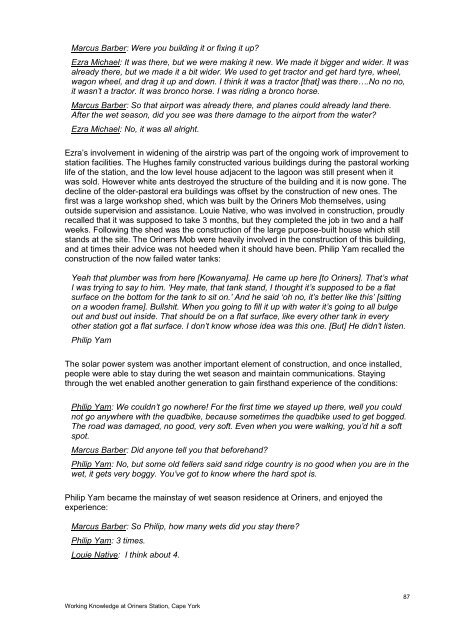WfHC - cover page (not to be used with pre-printed report ... - CSIRO
WfHC - cover page (not to be used with pre-printed report ... - CSIRO
WfHC - cover page (not to be used with pre-printed report ... - CSIRO
You also want an ePaper? Increase the reach of your titles
YUMPU automatically turns print PDFs into web optimized ePapers that Google loves.
Marcus Bar<strong>be</strong>r: Were you building it or fixing it up?<br />
Ezra Michael: It was there, but we were making it new. We made it bigger and wider. It was<br />
already there, but we made it a bit wider. We <strong>used</strong> <strong>to</strong> get trac<strong>to</strong>r and get hard tyre, wheel,<br />
wagon wheel, and drag it up and down. I think it was a trac<strong>to</strong>r [that] was there….No no no,<br />
it wasn‟t a trac<strong>to</strong>r. It was bronco horse. I was riding a bronco horse.<br />
Marcus Bar<strong>be</strong>r: So that airport was already there, and planes could already land there.<br />
After the wet season, did you see was there damage <strong>to</strong> the airport from the water?<br />
Ezra Michael: No, it was all alright.<br />
Ezra‟s involvement in widening of the airstrip was part of the ongoing work of improvement <strong>to</strong><br />
station facilities. The Hughes family constructed various buildings during the pas<strong>to</strong>ral working<br />
life of the station, and the low level house adjacent <strong>to</strong> the lagoon was still <strong>pre</strong>sent when it<br />
was sold. However white ants destroyed the structure of the building and it is now gone. The<br />
decline of the older-pas<strong>to</strong>ral era buildings was offset by the construction of new ones. The<br />
first was a large workshop shed, which was built by the Oriners Mob themselves, using<br />
outside supervision and assistance. Louie Native, who was involved in construction, proudly<br />
recalled that it was supposed <strong>to</strong> take 3 months, but they completed the job in two and a half<br />
weeks. Following the shed was the construction of the large purpose-built house which still<br />
stands at the site. The Oriners Mob were heavily involved in the construction of this building,<br />
and at times their advice was <strong>not</strong> heeded when it should have <strong>be</strong>en. Philip Yam recalled the<br />
construction of the now failed water tanks:<br />
Yeah that plum<strong>be</strong>r was from here [Kowanyama]. He came up here [<strong>to</strong> Oriners]. That‟s what<br />
I was trying <strong>to</strong> say <strong>to</strong> him. „Hey mate, that tank stand, I thought it‟s supposed <strong>to</strong> <strong>be</strong> a flat<br />
surface on the bot<strong>to</strong>m for the tank <strong>to</strong> sit on.‟ And he said „oh no, it‟s <strong>be</strong>tter like this‟ [sitting<br />
on a wooden frame]. Bullshit. When you going <strong>to</strong> fill it up <strong>with</strong> water it‟s going <strong>to</strong> all bulge<br />
out and bust out inside. That should <strong>be</strong> on a flat surface, like every other tank in every<br />
other station got a flat surface. I don‟t know whose idea was this one. [But] He didn‟t listen.<br />
Philip Yam<br />
The solar power system was a<strong>not</strong>her important element of construction, and once installed,<br />
people were able <strong>to</strong> stay during the wet season and maintain communications. Staying<br />
through the wet enabled a<strong>not</strong>her generation <strong>to</strong> gain firsthand experience of the conditions:<br />
Philip Yam: We couldn‟t go nowhere! For the first time we stayed up there, well you could<br />
<strong>not</strong> go anywhere <strong>with</strong> the quadbike, <strong>be</strong>cause sometimes the quadbike <strong>used</strong> <strong>to</strong> get bogged.<br />
The road was damaged, no good, very soft. Even when you were walking, you‟d hit a soft<br />
spot.<br />
Marcus Bar<strong>be</strong>r: Did anyone tell you that <strong>be</strong>forehand?<br />
Philip Yam: No, but some old fellers said sand ridge country is no good when you are in the<br />
wet, it gets very boggy. You‟ve got <strong>to</strong> know where the hard spot is.<br />
Philip Yam <strong>be</strong>came the mainstay of wet season residence at Oriners, and enjoyed the<br />
experience:<br />
Marcus Bar<strong>be</strong>r: So Philip, how many wets did you stay there?<br />
Philip Yam: 3 times.<br />
Louie Native: I think about 4.<br />
Working Knowledge at Oriners Station, Cape York<br />
87
















